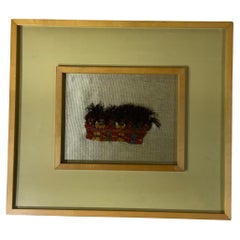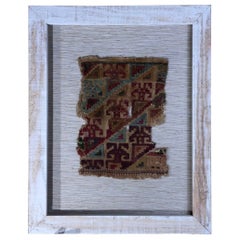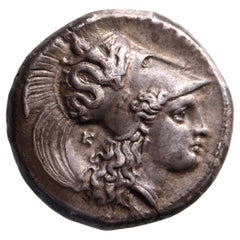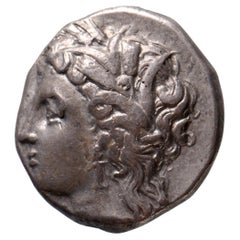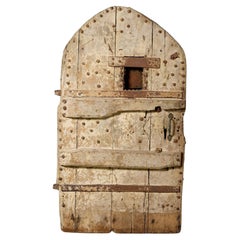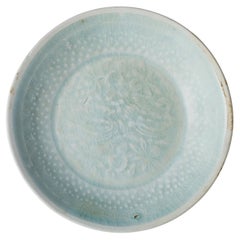15th Century and Earlier Furniture
11
2,755
to
341
1,226
865
2,755
2,755
2,755
19
7
4
4
4
2
2
1
1
1
1
1
1
1
38,942
130,213
515,993
267,350
82,055
254,133
118,705
12,511
5,825
18,010
22,624
19,325
53,653
72,121
59,208
21,165
8,683
1,084
760
644
345
304
1,338
623
517
383
299
29
8
4
3
3
Period: 15th Century and Earlier
Pre Colombian Proto Nazca Peruvian Textile Fragment
Located in Delray Beach, FL
A Proto-Nazca textile fragment from Southern Peru circa 100BC-200AD. The linked munecas ("dolls" in Spanish) figures were woven with fibers likely from llama and it was used to be t...
Category
Peruvian Antique 15th Century and Earlier Furniture
Materials
Wool, Natural Fiber, Glass, Wood
Pre Colombian Antique Peruvian Textile Fragment
Located in Delray Beach, FL
Museum quality handwoven textile fragment, featuring human , or Martian motif professionally mounted on cotton matte , in very decorative wood frame as shadows box . The textile date...
Category
Peruvian Antique 15th Century and Earlier Furniture
Materials
Wool, Natural Fiber, Glass, Wood
AR Stater Lucania, Herakleia
Located in UTRECHT, UT
Obverse: [HPAKLHIWN], head of Athena right, wearing crested Athenian helmet ornamented with Skylla; behind, K
Reverse: HPAKLHIWN, Herakles, naked, standing facing, holding club and b...
Category
Greek Classical Greek Antique 15th Century and Earlier Furniture
Materials
Silver
AR Stater Lucania, Metapontum
Located in UTRECHT, UT
Obverse: head of Demeter left, wearing barley wreath
Reverse: ΜΕΤA, ear of barley, pitchfork above leaf in left field
Weight: 7.84 g
Grade: About extremely fine
Reference: SNG ANS 4...
Category
Greek Classical Greek Antique 15th Century and Earlier Furniture
Materials
Silver
Rare 13th Century Medieval English Oak Door
Located in Wormelow, Herefordshire
A substantially constructed, heavy medieval era English oak door possibly dating from as early as the 13th century. This 800-year-old door is a rare find and originates from Leominst...
Category
Medieval Antique 15th Century and Earlier Furniture
Materials
Metal, Iron
A Molded Qingbai 'Flowers' Dish, Southern Song Dynasty
Located in seoul, KR
The plate depicted here exhibits the intricate floral patterns and lotus motifs that are typical of Southern Song designs. The central floral motif captures the essence of Oriental b...
Category
Chinese Ming Antique 15th Century and Earlier Furniture
Materials
Ceramic
Egyptian scarab with pseudo-hieroglyphic, Anra-type
Located in EL CAMPELLO, ES
ITEM: Scarab with pseudo-hieroglyphic, Anra-type
MATERIAL: Steatite
CULTURE: Egyptian
PERIOD: Second Intermediate Period, 1700 – 1550 B.C
DIMENSIONS: 10 mm x 15 mm
CONDITION: Good co...
Category
Egyptian Egyptian Antique 15th Century and Earlier Furniture
Materials
Stone
14th-16th Century, A Pair of Antique Sukhothai Pottery Brown Glazed Jars
Located in Sampantawong, TH
A pair of antique Sukhothai pottery brown glazed jars with naturally running glaze on the body, natural shell and barnacle from shipwreck.
Age: Thailand, Sukhothai Period, 14th - 16...
Category
Thai Antique 15th Century and Earlier Furniture
Materials
Pottery
Ancient Greek Corinthian Helmet
Located in London, GB
Corinthian helmet with Bull Horns and Lotus Flower Decoration.
Archaic Period, c.550-500 BC.
Cast, hammered and incised bronze.
An exceptionally well preserved example of one of the most iconic ancient Greek...
Category
European Classical Greek Antique 15th Century and Earlier Furniture
Materials
Bronze
A Longquan Celadon-Glazed 'Dragon' Dish, Yuan Dynasty
Located in seoul, KR
The dish is decorated to the centre with a moulded appliqué dragon chasing the flaming pearl surrounded by a carved stylised foliage band at the cavetto. The moulded fluted exterior ...
Category
Chinese Ming Antique 15th Century and Earlier Furniture
Materials
Celadon
Magnificent Aztec Eagle Head with pre-1970 UNESCO-compliant provenance
By Plateria Azteca
Located in Culver City, CA
Magnificent Aztec Basalt Eagle head, with powerful hooked beak, piercing
eyes, and a fully-feathered head.
The sculptor Highlighted the power of the head by finely burnishing the b...
Category
Mexican Pre-Columbian Antique 15th Century and Earlier Furniture
Materials
Stone
Egyptian scarab with spiral design
Located in EL CAMPELLO, ES
ITEM: Scarab with spiral design
MATERIAL: Steatite
CULTURE: Egyptian
PERIOD: Second Intermediate Period, 1700 – 1550 B.C
DIMENSIONS: 12 mm x 9 mm
CONDITION: Good condition
PROVENANCE...
Category
Egyptian Egyptian Antique 15th Century and Earlier Furniture
Materials
Stone
Egyptian scarab with Uraeus, Ankh and neb basket (Amun trigram)
Located in EL CAMPELLO, ES
ITEM: Scarab with Uraeus, Ankh and neb basket (Amun trigram)
MATERIAL: Steatite
CULTURE: Egyptian
PERIOD: New Kingdom, 1550 – 1070 B.C
DIMENSIONS: 12 mm x 8 mm
CONDITION: Good condit...
Category
Egyptian Egyptian Antique 15th Century and Earlier Furniture
Materials
Stone
Moldavite From the Czech Republic // 1.21 Grams
Located in New York, NY
This genuine moldavite in stellar condition offers a luminous green color and fascinating natural texture, making it an overall great specimen. Moldavite is one of the most sought af...
Category
Czech Antique 15th Century and Earlier Furniture
Materials
Other
Purple / Blue Fluorite Mineral Specimen – Xiayang Town, China
Located in Edison, NJ
This breathtaking specimen comes from a distinctive group of fluorites that have affectionately been nicknamed, “tanzanite fluorite” for their gemlike aesthetics and color-shifting a...
Category
Chinese Antique 15th Century and Earlier Furniture
Materials
Stone, Multi-gemstone
Scarab with prenomen for Amenhotep II
Located in EL CAMPELLO, ES
ITEM: Scarab with prenomen for Amenhotep II
MATERIAL: Steatite
CULTURE: Egyptian
PERIOD: New Kingdom, XVIIIth Dynasty, 1143 – 1417 B.C
DIMENSIONS: 15 mm x 11 mm
CONDITION: Good condi...
Category
Egyptian Egyptian Antique 15th Century and Earlier Furniture
Materials
Stone
Pre Columbian Maya Polychrome Pottery Bowl circa A.D. 550-950
Located in London, GB
Maya Poly-chrome painted pottery bowl
Guatemala/ central America late Classic period, circa A.D. 550-950,
A bowl of rounded bottom circular form, painted with a frieze of monkey...
Category
Guatemalan Antique 15th Century and Earlier Furniture
Materials
Pottery
Korean antique pottery vase/10th century/Wabi-Sabi vase/Goryeo period
Located in Sammu-shi, Chiba
This is hard earthenware made during the Goryeo period in Korea.
This vase was made around the 10th century.
The walls of the vase are thin, but because they are baked at high tempe...
Category
South Korean Other Antique 15th Century and Earlier Furniture
Materials
Pottery
Greek kylix
Located in EL CAMPELLO, ES
ITEM: Kylix
MATERIAL: Pottery
CULTURE: Greek, Apulian
PERIOD: 4th Century B.C
DIMENSIONS: 56 mm x 165 mm x 115 mm
CONDITION: Good condition
PROVENANCE: Ex Belgian private collection,...
Category
Greek Classical Greek Antique 15th Century and Earlier Furniture
Materials
Pottery
278 Gram Campo del Cielo Meteorite // 4.6 Billion Years Old
Located in New York, NY
The Campo del Cielo iron meteorites were discovered in 1576 about 500 miles northwest of Buenos Aires, Argentina. Testing proved the "rocks" to be meteorites.
It is estimated that t...
Category
Argentine Antique 15th Century and Earlier Furniture
Materials
Iron, Nickel
Egyptian scarab as a commemorative of Ramesses II or prenomen of Shoshenq III
Located in EL CAMPELLO, ES
ITEM: Scarab as a commemorative of Ramesses II or prenomen of Shoshenq III
MATERIAL: Black steatite
CULTURE: Egyptian
PERIOD: New Kingdom to Third Intermediate Period, 1279 – 664 B.C...
Category
Egyptian Egyptian Antique 15th Century and Earlier Furniture
Materials
Stone
Seymchan Corner-Cut Pallasite Meteorite
Located in New York, NY
The Seymchan meteorite is a pallasite meteorite found in Russia in the settlement of Seymchan. Discovered in 1967, it is one of only a few pallasite meteorites - a type of meteorite ...
Category
Russian Antique 15th Century and Earlier Furniture
Materials
Other
Medieval English Alabaster Statue
Located in Wormelow, Herefordshire
A medieval English alabaster statue, possibly dating as far back as the late 14th / early 15th century, mounted on one of our exclusive large display plinths. Well weathered over the centuries, this 600-year-old statue depicts a medieval cloaked figure, possibly a monk, offering a glimpse into English architecture and sculpture of the Middle Ages.
This sculpture is possibly made from Nottingham alabaster. During the 14th and 15th centuries, Nottingham was the centre of alabaster carving and painting. Alabaster works were mostly made as small alabaster models with religious themes. During the 16th century Reformation, many alabaster carvings were destroyed under King Henry VIII's rule, making any surviving examples even more significant.
Provenance
From the collection of Peter Hone (b. 1941). A master plaster caster, he is an expert and experienced collector, building up an extraordinary, museum-worthy collection of items in his one-bedroom flat in London W11...
Category
English Medieval Antique 15th Century and Earlier Furniture
Materials
Alabaster
Genuine Natural Carcharodontosaurus Dinosaur Tooth (74 grams)
Located in New York, NY
Carcharodontosaurus (Dinosaur) tooth in a glass display box From Tegana Formation, North Africa.
Cretaceous Age 65 million years
Carcharodontosaurus is one of the longest and heavi...
Category
Egyptian Antique 15th Century and Earlier Furniture
Materials
Other
Pre Columbian Colima Dog Ancient West Mexico Latin American Antiques Art
Located in London, GB
Pre Columbian Colima Dog Ancient West Mexico
Pre-Columbian, West Mexico, Colima Ancient Mexico C 200 BC –400 AD
A attractive seated Colima dog v...
Category
Mexican Antique 15th Century and Earlier Furniture
Materials
Pottery
Annamese stoneware with underglaze blue, Hoi An hoard, late 15th century
Located in seoul, KR
Decorated with floral and foliate reserves and clouds; lappets at base and leaves at neck.
Dates : 15th century Le Dynasty
Region : North Annam
Type : Yuhuchun Vase
Found/Acquired : Southeast Asia , South China Sea, Hoi An Ship
Reference :
1) Art Gallery of Greater Victoria - A vase from the wreck of the Hoi An
2) Butterfield Treasures Hoi An Hoard...
Category
Chinese Ming Antique 15th Century and Earlier Furniture
Materials
Stoneware
Roman relief of Medusa and Hercules knot
Located in EL CAMPELLO, ES
ITEM: Relief of Medusa and Hercules knot
MATERIAL: Limestone
CULTURE: Roman
PERIOD: 2nd – 3rd Century A.D
DIMENSIONS: 465 mm x 362 mm x 103 mm (without stand)
CONDITION: Good conditi...
Category
Italian Classical Roman Antique 15th Century and Earlier Furniture
Materials
Limestone
Roman mosaic depicting a bird
Located in EL CAMPELLO, ES
ITEM: Mosaic depicting a bird
MATERIAL: Tesserae
CULTURE: Roman
PERIOD: 3rd Century A.D
DIMENSIONS: 400 mm x 440 mm x 40 mm
CONDITION: Good condition
PROVENANCE: Ex Swiss private col...
Category
Italian Classical Roman Antique 15th Century and Earlier Furniture
Materials
Marble
Japanese Antique Large Pottery Vase 14-16th Century / Flower Vase Wabisabi
Located in Sammu-shi, Chiba
This is a very old and large Japanese pottery.
It is called Tokoname-yaki.
This pottery was made from the 14th to 16th century.
The distorted shape is very unique.
It is very beauti...
Category
Japanese Other Antique 15th Century and Earlier Furniture
Materials
Pottery
Ancient Antique Luristan Bronze Sword / Knife / Dagger / Early Iron Age Weapon
Located in Sampantawong, TH
Ancient Luristan bronze sword with green patina.
Luristan bronze comes from the province of Lorestan, a region of nowadays Western Iran in the Zagros Mountains. With its rich and lo...
Category
Persian Antique 15th Century and Earlier Furniture
Materials
Bronze
Calcite on Amethyst cluster From San Eugenio, Artigas Dept., Uruguay
Located in New York, NY
From San Eugenio, Artigas Dept., Uruguay
Sharp crystal cluster in a parallel formation of scalenohedral calcite crystals on matrix with lustrous translucent grape purple amethyst c...
Category
Uruguayan Antique 15th Century and Earlier Furniture
Materials
Amethyst, Crystal, Other
Dominican Amber // 15-25 MYO
Located in New York, NY
This large, translucent piece of amber is from the Dominican Republic and is an estimated 16 to 25 million years old. Amber is fossilized tree resin and is considered a mineraloid. T...
Category
Dominican Antique 15th Century and Earlier Furniture
Materials
Resin
Exceptional Egyptian Sarcophagus Mask
Located in London, GB
Exceptionally Fine Wooden Sarcophagus Mask
Third Intermediate Period, 21st Dynasty, circa 1069-945 BC.
Acacia wood, rosewood, hippopotamus ivory
Masterfully carved from a single piece of fine-grained hardwood, the present mask is characteristic of the most exquisite funerary art made during the 21st Dynasty, and was probably commissioned for a particularly high-ranking individual.
The oval face displays a gently smiling mouth with full, outlined lips, furrows at the corners and a bow-shaped philtrum. The straight nose with rounded nostrils, the cheeks full and fleshy and the large, almond shaped eyes with heavy lids and tapering cosmetic lines, set below long, sweeping eyebrows.
Social collapse across the Mediterranean in the Late Bronze Age meant that the 21st Dynasty in Egypt was a period of great turmoil. Trade routes were disrupted, governments collapsed, and mass migration occurred. Economic scarcity meant that traditional funerary practices in Egypt were also affected, with a lack of material and financial resources leading to the reuse of preexisting material. As a result, during the 21st Dynasty, 19th and 20th Dynasty coffins changed ownership rapidly and were heavily recycled for new purposes. Tombs were also unmarked allowing them to be shared
by many people. These new practices brought forth a shift in the understanding of funerary paraphernalia. No longer important objects owned forever by the deceased, they were now simply seen as short-term transformative devices, whose symbolic and ritualistic meaning could be appropriated for others. However, paradoxically, the art of coffin-making also reached new heights during this period, and many of the richly dec- orated “yellow” coffins, characteristic of the 21st Dynasty, are remarkable works of art in their own right. Indeed, knowing that coffins were being reused throughout Egypt, the Egyptian élite set themself apart by commissioning lavish sarcophagi decorated with the images and texts meant to help guide them to the afterlife, and which would otherwise have adorned the tomb walls. As coffins were the chief funerary element which now identified the dead and allowed them a physical presence in the world of the living, their quality and appearance were of the utmost importance.
The traditional coffin ensemble was made of three parts: a wooden mummy cover, which laid directly atop the mummy, an inner coffin, and an outer coffin, both made of a lid and case. Additional decorative elements, such as masks, were carved out separately and later glued or pegged to the lids. After the completion of the painted decoration, the sarcophagus was covered in a varnish to give it its yellow colour. Gilding was sometimes used for the coffins of the high priests’ families, notably on parts representing naked skin, such as the face mask. However, some of the élite tactically avoided gilding altogether as to ensure that their coffin would not be looted.
When manufacturing the inner and outer coffins, particular attention was paid to the woodwork. Displaying the skill of the carpenter, this type of funerary art has largely remained unparalleled throughout Egyptian history. The principal wood used to craft the present mask is Acacia nilotica. The evergreen Egyptian acacia was considered sacred and said to be the tree of life, the birthplace of the god Horus, as well as symbolic of Osiris, the god of the dead and resurrection. The modelling of the face in the wood is superb, but the inlays also help mark this mask out as exceptional. Inlaid eyes and eyebrows were extremely rare and reserved to the finest and most expensive coffins. Traditionally, eyes were made of calcite, obsidian, or quartz, and eyebrows of coloured glass paste or bronze. Here, the pupils, eyebrows, and cosmetic lines are inlaid with Dalbergia melanoxylon, a rare type of wood which belongs to the rosewood genus.
In antiquity, however, it was known as Ebony of the Pharaohs, from the Egyptian word “hbny”, meaning dark timber, because of its black, lustrous appearance. An extremely dense and hard wood requiring significant skill to work with, ebony was a luxury material highly coveted by the pharaohs themselves, to make furniture, decorative and funerary objects. The wood was imported with great effort from the southern Land of Punt, most likely modern Sudan, Ethiopia, Djibouti, and Eritrea, alongside other luxury goods such as gold and ivory.
A magnificent ebony throne, recovered in the tomb of King Tutankhamun, illustrates the incredible aesthetic potential of this material and why it was so highly valued by Egyptian royalty. Only élite members of Egyptian society could have afford- ed Ebony of the Pharaoh inlays for their funerary mask.
The sclerae on the present piece were once both inlaid with hippopotamus ivory. Whiter than elephant ivory, this type of ivory is also denser, and more difficult to carve. The use of this luxury material, reputed for its gleaming appearance, enhances the lifelikeness of the eyes. For the Egyptians, hippopotamus ivory was imbued with magic powers. The hippopotamus was indeed both feared and venerated due to its aggressive behaviour. Whilst the male hippopotamus was associated with danger and chaos, the female was benevolent and invoked for protection, especially of the house and
of mothers and their children, through the hippopotamus goddess Tawaret. Thus, not only was hippopotamus ivory used as an inlay and to make practical objects, such as combs and clappers, but it was also used to make talismans like apotropaic wands or knives.
Made during a time of scarcity where few could afford made-to-order coffins, the present mask could have only belonged to one of the highest-ranking individuals in society. Undoubtedly one of the finest Egyptian coffin...
Category
Egyptian Egyptian Antique 15th Century and Earlier Furniture
Materials
Fruitwood, Hardwood
Stunning Large agate grape
Located in London, GB
Intense purple latte aesthetic grape agate. A wonderful, sculptural arrangement!
Origin: Indonesia
Category
Indonesian Antique 15th Century and Earlier Furniture
Materials
Agate, Rock Crystal
Aztec Sculpture of a Spider Monkey with Pre-1970 UNESCO-Compliant Provenance
Located in Culver City, CA
Aztec Spider Monkey with Wind God Regalia
This sculpture portrays a spider monkey (Ateles geofroyi) wearing the regalia associated with the Aztec Wind God, Quetzalcoatl-Ehecatl. Th...
Category
Mexican Pre-Columbian Antique 15th Century and Earlier Furniture
Materials
Stone
Greek aryballos depicting a horse head
Located in EL CAMPELLO, ES
ITEM: Aryballos depicting a horse head
MATERIAL: Pottery
CULTURE: Greek, Corinthian
PERIOD: 7th Century B.C
DIMENSIONS: 62 mm x 55 mm diameter
CONDITION: Good condition
PROVENANCE: E...
Category
Greek Classical Greek Antique 15th Century and Earlier Furniture
Materials
Pottery
Greek head
Located in EL CAMPELLO, ES
ITEM: Head
MATERIAL: Marble
CULTURE: Greek, Hellenistic period
PERIOD: 3rd – 1st Century B.C
DIMENSIONS: 55 mm x 47 mm x 47 mm
CONDITION: Good condition. Includes stand
PROVENANCE: E...
Category
Greek Classical Greek Antique 15th Century and Earlier Furniture
Materials
Marble
Chinese statuette of a Fat Lady
Located in EL CAMPELLO, ES
ITEM: Statuette of a Fat Lady
MATERIAL: Pottery
CULTURE: Chinese, Tang Dynasty
PERIOD: 618 – 907 A.D
DIMENSIONS: 655 mm x 265 mm x 210 mm
CONDITION: Good condition. Includes Thermoluminescence test by Laboratory Kotalla (Reference 05B101123). Includes Certificate of Authenticity from Dutch gallery
PROVENANCE: Ex Belgian private collection, acquired from Dutch art gallery
Comes with Certificate of Authenticity and Export Licence. If you are from outside the European Union, we will have to apply for the export licence again for your country, this takes 4 to 6 weeks.
Due to the fragility and size of this piece, it can only be shipped within the European Union, United Kingdom and neighbouring countries that can be transported by road by private courier (door to door).
This beautifully-finished ceramic attendant was made during what many consider to be China’s Golden Age, the Tang Dynasty. It was at this point that China’s outstanding technological and aesthetic achievements opened to external influences, resulting in the introduction of numerous new forms of self-expression, coupled with internal innovation and considerable social freedom. The Tang dynasty also saw the birth of the printed novel, significant musical and theatrical heritage and many of China’s best- known painters and artists.
The Tang Dynasty was created on the 18th of June, 618 AD, when the Li family seized power from the last crumbling remnants of the preceding Sui Dynasty. This political and regal regime was long-lived, and lasted for almost 300 years. The imperial aspirations of the preceding periods and early Tang leaders led to unprecedented wealth, resulting in considerable socioeconomic stability, the development of trade networks and vast urbanisation for China’s exploding population (estimated at around 50 million people in the 8th century AD). The Tang rulers took cues from earlier periods, maintaining many of their administrative structures and systems intact. Even when dynastic and governmental institutions withdrew from management of the empire towards the end of the period – their authority undermined by localised rebellions and regional governors known as jiedushi –the systems were so well- established that they continued to operate regardless.
The artworks created during this era are among China’s greatest cultural achievements. It was the greatest age for Chinese poetry and painting, and sculpture also developed (although there was a notable decline in Buddhist sculptures following repression of the faith by pro-Taoism administrations later in the regime). It is disarming to note that the eventual decline of imperial power, followed by the official end of the dynasty on the 4th of June 907, hardly affected the great artistic turnover.
During the Tang Dynasty, restrictions were placed on the number of objects that could be included in tombs, an amount determined by an individual’s social rank. In spite of the limitations, a striking variety of tomb furnishings – known as mingqi – have been excavated. Entire retinues of ceramic figures – representing warriors, animals, entertainers, musicians, guardians and every other necessary category of assistant – were buried with the dead in order to provide for the afterlife. Warriors (lokapala) were put in place to defend the dead, while horses/ camels were provided for transport, and officials to run his estate in the hereafter. Of all the various types of mingqi, however, there are none more elegant or charming than the sculptures of sophisticated female courtiers, known – rather unfairly – as “fat ladies...
Category
Chinese Tang Antique 15th Century and Earlier Furniture
Materials
Pottery
Genuine Large Spinosaurus Dinosaur Tooth in Display Box (77 grams)
Located in New York, NY
This huge, Museum-quality Spinosaur tooth is completely in tact with no repairs. This incredible specimen includes a display box for preservation and display purposes. Spinosaurus (m...
Category
Antique 15th Century and Earlier Furniture
Materials
Other
Pair of Small Korean Celadon Inlay Vases Goryeo Dynasty
Located in Atlanta, GA
On offer is a near pair antique Korean ceramic vase from the end of Goryeo to the beginning of Joseon period (circa 14-15th). The vases feature cel...
Category
Korean Archaistic Antique 15th Century and Earlier Furniture
Materials
Ceramic
Guardian(Half human half beast) Pottery Figure, Northern Wei-Tang Dynasty
Located in seoul, KR
This guardian figure represents a fusion of human and beast, a common motif symbolizing protection in Chinese lore. Crafted from pottery, the figure is a testament to the era's sculp...
Category
Chinese Han Antique 15th Century and Earlier Furniture
Materials
Pottery
Chinese statuette of a Fat Lady
Located in EL CAMPELLO, ES
ITEM: Statuette of a Fat Lady
MATERIAL: Pottery
CULTURE: Chinese, Tang Dynasty
PERIOD: 618 – 907 A.D
DIMENSIONS: 645 mm x 260 mm x 180 mm
CONDITION: Good condition. Includes Thermoluminescence test by Laboratory Kotalla (Reference 04B101123). Includes Certificate of Authenticity from Dutch gallery
PROVENANCE: Ex Belgian private collection, acquired from Dutch art gallery
Comes with Certificate of Authenticity and Export Licence. If you are from outside the European Union, we will have to apply for the export licence again for your country, this takes 4 to 6 weeks.
Due to the fragility and size of this piece, it can only be shipped within the European Union, United Kingdom and neighbouring countries that can be transported by road by private courier (door to door).
This beautifully-finished ceramic attendant was made during what many consider to be China’s Golden Age, the Tang Dynasty. It was at this point that China’s outstanding technological and aesthetic achievements opened to external influences, resulting in the introduction of numerous new forms of self-expression, coupled with internal innovation and considerable social freedom. The Tang dynasty also saw the birth of the printed novel, significant musical and theatrical heritage and many of China’s best- known painters and artists.
The Tang Dynasty was created on the 18th of June, 618 AD, when the Li family seized power from the last crumbling remnants of the preceding Sui Dynasty. This political and regal regime was long-lived, and lasted for almost 300 years. The imperial aspirations of the preceding periods and early Tang leaders led to unprecedented wealth, resulting in considerable socioeconomic stability, the development of trade networks and vast urbanisation for China’s exploding population (estimated at around 50 million people in the 8th century AD). The Tang rulers took cues from earlier periods, maintaining many of their administrative structures and systems intact. Even when dynastic and governmental institutions withdrew from management of the empire towards the end of the period – their authority undermined by localised rebellions and regional governors known as jiedushi –the systems were so well- established that they continued to operate regardless.
The artworks created during this era are among China’s greatest cultural achievements. It was the greatest age for Chinese poetry and painting, and sculpture also developed (although there was a notable decline in Buddhist sculptures following repression of the faith by pro-Taoism administrations later in the regime). It is disarming to note that the eventual decline of imperial power, followed by the official end of the dynasty on the 4th of June 907, hardly affected the great artistic turnover.
During the Tang Dynasty, restrictions were placed on the number of objects that could be included in tombs, an amount determined by an individual’s social rank. In spite of the limitations, a striking variety of tomb furnishings – known as mingqi – have been excavated. Entire retinues of ceramic figures – representing warriors, animals, entertainers, musicians, guardians and every other necessary category of assistant – were buried with the dead in order to provide for the afterlife. Warriors (lokapala) were put in place to defend the dead, while horses/ camels were provided for transport, and officials to run his estate in the hereafter. Of all the various types of mingqi, however, there are none more elegant or charming than the sculptures of sophisticated female courtiers, known – rather unfairly – as “fat ladies...
Category
Chinese Tang Antique 15th Century and Earlier Furniture
Materials
Pottery
Greek piriform aryballos with scale pattern
Located in EL CAMPELLO, ES
ITEM: Piriform aryballos with scale pattern
MATERIAL: Pottery
CULTURE: Greek, Corinthian
PERIOD: 7th Century B.C
DIMENSIONS: 116 mm x 57 mm
CONDITION: Good condition, handle repaired...
Category
Greek Classical Greek Antique 15th Century and Earlier Furniture
Materials
Pottery
Romano-Egyptian cartonnage mummy mask depicting a female head
Located in EL CAMPELLO, ES
ITEM: Romano-Egyptian cartonnage mummy mask depicting a female head
MATERIAL: Linen and Gesso
CULTURE: Egyptian, Roman period
PERIOD: 1st Century B.C – 1st Century A.D
DIMENSIONS: 20...
Category
Egyptian Classical Roman Antique 15th Century and Earlier Furniture
Materials
Gesso, Linen
Greek head
Located in EL CAMPELLO, ES
ITEM: Head
MATERIAL: Marble
CULTURE: Greek, Hellenistic period
PERIOD: 3rd – 1st Century B.C
DIMENSIONS: 55 mm x 38 mm x 44 mm
CONDITION: Good condition. Includes stand
PROVENANCE: E...
Category
Greek Classical Greek Antique 15th Century and Earlier Furniture
Materials
Marble
Natural Petrified Wood Sculpture
Located in New York, NY
A natural piece of Petrified Wood set on a stand. Completely organic natural raw fossil, cleaned for display. The natural process for petrified wood to be created takes hundreds to...
Category
Thai Organic Modern Antique 15th Century and Earlier Furniture
Materials
Stone
Genuine Natural Carcharodontosaurus Dinosaur Tooth (43 grams)
Located in New York, NY
Carcharodontosaurus (Dinosaur) tooth in a glass display box From Tegana Formation, North Africa.
Cretaceous Age 65 million years
Carcharodontosaurus is one of the longest and heavi...
Category
Egyptian Antique 15th Century and Earlier Furniture
Materials
Other
Neolithic Yangshao Culture Pottery Amphora, 3rd-2nd Millenium BC
Located in seoul, KR
This pottery has a bulbous body with two small, protruding handles near its widest part. The pottery features horizontal bands of patterns, which include a sequence of geometric shap...
Category
Chinese Antique 15th Century and Earlier Furniture
Materials
Pottery
Pre Columbian Narino Carchi Coquero Coca chewer Figure Columbia
Located in London, GB
A hand modelled statue of a male coca chewer figure , known as a Coquero, wearing a sash sitting upon a bench, the coca quid in his right cheek, with black negative resist design
Pr...
Category
Colombian Antique 15th Century and Earlier Furniture
Materials
Pottery
Greek skyphos
Located in EL CAMPELLO, ES
ITEM: Skyphos
MATERIAL: Pottery
CULTURE: Greek
PERIOD: 4th Century B.C
DIMENSIONS: 125 mm x 220 mm
CONDITION: Good condition
PROVENANCE: Ex Swiss private collection, acquired since a...
Category
Greek Classical Greek Antique 15th Century and Earlier Furniture
Materials
Pottery
Roman shipwreck amphora, Type Dressel 3
Located in EL CAMPELLO, ES
ITEM: Shipwreck amphora, Type Dressel 3
MATERIAL: Pottery
CULTURE: Roman
PERIOD: 1st – 2nd Century A.D
DIMENSIONS: 84 cm x 26 cm diameter (without st...
Category
Italian Classical Roman Antique 15th Century and Earlier Furniture
Materials
Pottery
Roman shipwreck amphora, Type Dressel 1B
Located in EL CAMPELLO, ES
ITEM: Shipwreck amphora, Type Dressel 1B
MATERIAL: Pottery
CULTURE: Roman, Republican period
PERIOD: 2nd – 1st Century B.C
DIMENSIONS: 110 cm x 29 cm...
Category
Italian Classical Roman Antique 15th Century and Earlier Furniture
Materials
Pottery
Heavenly Beings Carved Limestone Stele Fragment, Northern/Eastern Wei Dynasty
Located in seoul, KR
Flying two heavenly beings depicted in the stone. They are celestial beings called an Apsara. While having the same fragment and shape, another work I uploaded exhibits small dots on...
Category
Chinese Han Antique 15th Century and Earlier Furniture
Materials
Limestone
11C Red Sandstone Pot Bellied Vishnu Carving
Located in Dallas, TX
Presenting a stunning 11C Red Sandstone Pot Bellied Vishnu carving.
From Central India.
This piece has impeccable Provenance !
It was purchased by a...
Category
Indian Archaistic Antique 15th Century and Earlier Furniture
Materials
Sandstone
Genuine Natural Carcharodontosaurus Dinosaur Tooth (91 grams)
Located in New York, NY
Carcharodontosaurus (Dinosaur) tooth in a glass display box From Tegana Formation, North Africa.
Cretaceous Age 65 million years
Carcharodontosaurus is one of the longest and heavi...
Category
Egyptian Antique 15th Century and Earlier Furniture
Materials
Other
Ancient Antique Luristan Bronze Spear Early Iron Age Weapon
Located in Sampantawong, TH
Ancient Luristan bronze spear with excellent green patina.
Luristan bronze comes from the province of Lorestan, a region of nowadays Western I...
Category
Persian Antique 15th Century and Earlier Furniture
Materials
Bronze
AR Drachm Attica, Athens
Located in UTRECHT, UT
Obverse: head of Athena right, wearing earring, necklace, and crested Attic helmet decorated with three olive leaves over visor and spiral palmette
Reverse: owl standing right with h...
Category
Greek Classical Greek Antique 15th Century and Earlier Furniture
Materials
Silver
Petite Neolithic Chinese Terracotta Jar
Located in Chicago, IL
This petite ceramic jar is believed to be a later example of Neolithic Chinese redware pottery of the Yangshao culture. Although its exact age is unknown, the jar was likely created ...
Category
Chinese Chinese Export Antique 15th Century and Earlier Furniture
Materials
Terracotta
Recently Viewed
View AllMore Ways To Browse
Cabinet Hardware Handle
Carved Wood Display Cabinet
Art Deco 1915
Carved Mahogany Chest
Cabinet With Wrought Iron
Art Deco Made In Usa
Bedside Cabinet Vintage Bedside Tables And Cabinets
Wash Cabinet
Bow Front Chest Drawers
Cabinet Black And Green
Wood Chisel
Wooden Door Handle
Cabinets With Hutch
Cabinet Hard Wood
Chairs with Adjustable Height
Cabinet With Draws
Classic Brass Mirror
Bronze Door Handle
